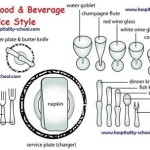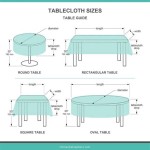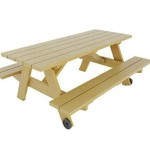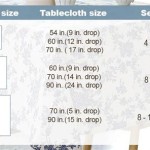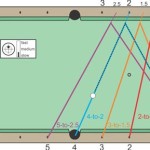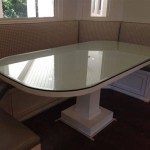Wall Mirror With Table: A Functional and Aesthetic Addition to Interior Design
The combination of a wall mirror and a table presents a practical and visually appealing solution for various spaces within a home or commercial setting. This pairing, often referred to as a wall mirror with a table or a console table with a mirror, merges the reflective properties of a mirror with the functional surface of a table, enhancing both the utility and aesthetic of an area. The integration of these elements provides a space for storage, display, and personal grooming, while simultaneously contributing to the overall ambiance and perceived size of the room.
This design concept is not entirely new, as mirrored surfaces have been incorporated into furniture for centuries. However, modern interpretations offer a range of styles, materials, and configurations, allowing for greater flexibility in adapting to diverse design preferences and spatial requirements. The choices available range from minimalist designs with clean lines to more ornate and elaborate constructions featuring intricate detailing. The functionality remains consistent: providing a convenient surface accompanied by the visual benefits of a mirror.
The specific advantages and applications of a wall mirror with a table depend heavily on the chosen design and the intended location. This article will explore the key features, benefits, and considerations involved in selecting and utilizing a wall mirror with a table, offering insights into how this combination can effectively improve the functionality and aesthetic appeal of various spaces.
Enhancing Space and Light
One of the primary advantages of incorporating a wall mirror with a table is its ability to enhance the perceived size and brightness of a room. Mirrors inherently create an illusion of depth by reflecting light and the surrounding environment. This is particularly beneficial in smaller spaces, such as entryways, hallways, or bathrooms, where the addition of a large mirror can significantly expand the feeling of openness. A well-positioned mirror can reflect natural light from windows, further illuminating the space and reducing the need for artificial lighting during the day.
The strategic placement of the mirror is crucial to maximizing its impact. Consider the objects or areas that the mirror will reflect. Ideally, the reflected view should be visually appealing and contribute to the overall aesthetic of the room. Avoid placing the mirror in a position that reflects clutter or undesirable elements. Instead, prioritize reflecting natural light sources, architectural features, or decorative accents.
The size and shape of the mirror also play a significant role in its effectiveness. A larger mirror will generally create a greater sense of depth and openness, while a smaller mirror can be used to highlight specific areas or features. The shape of the mirror can also complement the style of the room. Rectangular mirrors are often used in contemporary settings, while round or oval mirrors can soften the lines of a more traditional space. Furthermore, mirrored furniture pieces, such as tables with mirrored inlays or entire mirrored surfaces, can amplify this effect.
The table component adds to this by allowing for the display of lighting fixtures such as lamps, which casts more light onto the reflective surface of the mirror. This creates a positive feedback loop in which the fixture brightens the area and the mirror reflects it further. The combined effect can dramatically improve the ambiance of a space, especially during the evening hours.
Providing Functional Utility
Beyond its aesthetic contributions, a wall mirror with a table offers practical functionality in various settings. The table surface provides a convenient space for storing or displaying items, while the mirror offers a reflective surface for personal grooming or checking one's appearance. This combination makes it particularly useful in entryways, bathrooms, and bedrooms.
In an entryway, a console table with a mirror can serve as a central point for organizing everyday essentials. Keys, wallets, mail, and other small items can be placed on the table, providing a designated spot for these items and preventing clutter. The mirror allows for a quick check of one's appearance before leaving the house. Some tables also include drawers or shelves, offering additional storage space for items such as gloves, hats, or scarves.
In a bathroom, a vanity table with a mirror is a common fixture. This combination provides a dedicated space for applying makeup, styling hair, or performing other personal grooming tasks. The table surface can house cosmetics, brushes, and other beauty products, while the mirror offers a clear reflection for precise application. The size and style of the vanity table should be chosen to complement the overall design of the bathroom.
In a bedroom, a dressing table with a mirror can serve as a stylish and functional addition. Similar to a vanity table, a dressing table provides a space for personal grooming and storage of beauty products. It can also be used as a desk or workspace, depending on the needs of the individual. The mirror allows for viewing outfits and ensuring a polished appearance. The choice of design and materials should align with the overall aesthetic of the bedroom.
The height of the table and the placement of the mirror are essential considerations for optimal functionality. The table should be at a comfortable height for the intended use, whether it is for storage, display, or personal grooming. The mirror should be positioned at a height that allows for a clear reflection of one's face and upper body. Adjustable mirrors can provide greater flexibility in accommodating different heights and viewing angles.
Enhancing Decor and Style
A wall mirror with a table can significantly enhance the decor and style of a room, serving as a focal point and contributing to the overall aesthetic. The choice of materials, finishes, and design elements can be tailored to complement the existing decor or to create a contrasting statement piece. The style of the mirror and table should be carefully considered to ensure that they align with the desired look and feel of the space.
The materials used in the construction of the mirror and table can greatly influence their visual appeal. Wood is a classic choice that can add warmth and character to a room. Different types of wood, such as oak, maple, or walnut, offer varying colors and grain patterns. Metal frames can provide a sleek and modern look, while glass or acrylic can create a minimalist and contemporary feel. Stone countertops, such as marble or granite, can add a touch of luxury and sophistication.
The finishes applied to the materials can further enhance their aesthetic appeal. Painted finishes can be used to match or complement the colors in the room. Stained finishes can highlight the natural beauty of the wood grain. Metal finishes, such as brushed nickel or polished chrome, can add a touch of elegance. The choice of finish should be consistent with the overall style of the room.
The design of the mirror and table should also be carefully considered. Simple and minimalist designs are well-suited for contemporary spaces, while more ornate and decorative designs can add a touch of traditional elegance. Geometric shapes, such as squares, rectangles, or circles, can create a modern and sophisticated look. Curved lines and intricate details can add a touch of romance and femininity.
The mirror frame itself can be a significant design element. Ornate frames with carvings, moldings, or embellishments can add a touch of luxury and sophistication. Simple and minimalist frames can create a clean and modern look. Frameless mirrors offer a sleek and contemporary feel. The choice of frame should be consistent with the overall style of the room.
Accessories and decorative items can be used to further enhance the aesthetic appeal of the wall mirror with a table. Vases, candles, picture frames, and other small objects can be placed on the table to add personality and visual interest. The objects should be chosen to complement the style of the mirror and table, and they should be arranged in a visually pleasing manner. The mirror can also be used to reflect other decorative elements in the room, creating a harmonious and cohesive look.
Choosing the Right Size and Placement
Determining the appropriate size and placement of a wall mirror with a table is crucial for achieving both functionality and aesthetic harmony. The size of the table and mirror should be proportionate to the dimensions of the wall and the overall space. A large mirror in a small room can feel overwhelming, while a small mirror in a large room may appear insignificant. Similarly, the table should be sized appropriately for the intended use and the available space.
The height of the table is an important consideration, especially if it will be used for personal grooming. The table should be at a comfortable height for sitting or standing, depending on the intended use. The mirror should be positioned at a height that allows for a clear reflection of the face and upper body. Adjustable mirrors can provide greater flexibility in accommodating different heights and viewing angles.
The placement of the wall mirror with a table should be strategic, taking into account the light sources, the surrounding furniture, and the overall design of the room. Consider the objects or areas that the mirror will reflect. Ideally, the reflected view should be visually appealing and contribute to the overall aesthetic of the room. Avoid placing the mirror in a position that reflects clutter or undesirable elements.
In an entryway, the table should be placed near the door for easy access to everyday essentials. The mirror should be positioned at a height that allows for a quick check of one's appearance before leaving the house. In a bathroom, the vanity table should be placed near a sink and a light source. The mirror should be positioned at a height that allows for comfortable personal grooming. In a bedroom, the dressing table can be placed near a window or a closet for convenient access to clothing and natural light.
Consider the surrounding furniture and accessories when choosing the placement of the wall mirror with a table. The table should be positioned so that it does not obstruct traffic flow or impede access to other furniture. The mirror should be placed in a way that complements the surrounding design elements. For example, a mirror can be used to reflect a piece of artwork or to create a sense of symmetry in the room.
The electrical outlets and lighting fixtures should also be taken into account when choosing the placement of the wall mirror with a table. If the table will be used for personal grooming, access to an electrical outlet for hair dryers or curling irons is essential. Adequate lighting is also crucial for accurate makeup application and other grooming tasks. Consider adding a sconce or a vanity light above the mirror to provide additional illumination.

Decorative Mirrors Bathroom Table

Large Wall Mirror Behind Console Table In Entryway Furniture Singapore

Table Mirror Ts 001 Dbr

Etienne Modern Hallway Wall Mirror Table Urban Mood
Greatshore 1pc Vintage Wall Mirror Hanging Decorative Retro Home Decor Table Oval Sg Ee Singapore

Pin On Home Ideas

Top 20 Modern Console Tables Mirror Wall Living Room Bedroom

Attractive Mirror Dressing Table Designs For Beginners Foyer Design Modern

Knightsbridge Rectangle Wall Mirror With Console Table And Side Set

Etienne Modern Hallway Wall Mirror Table Urban Mood

